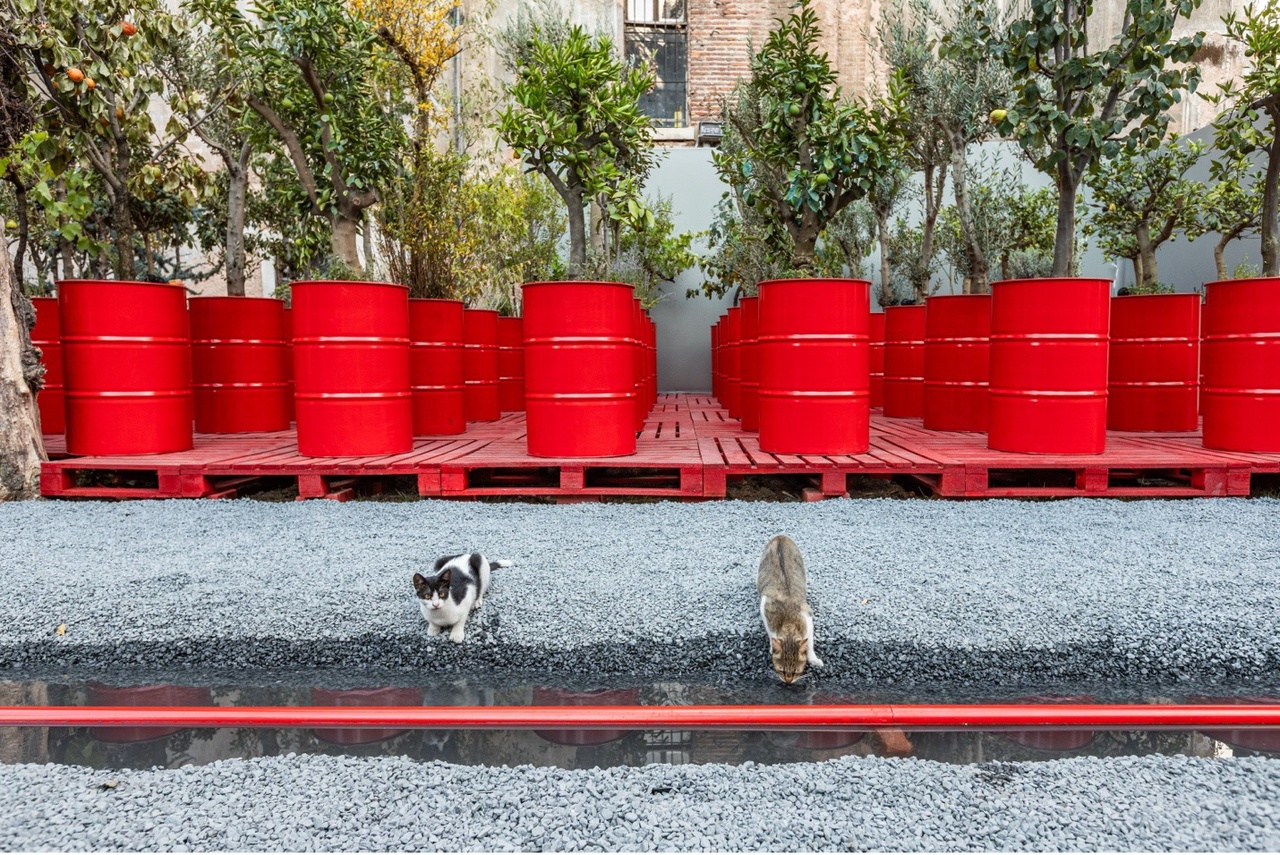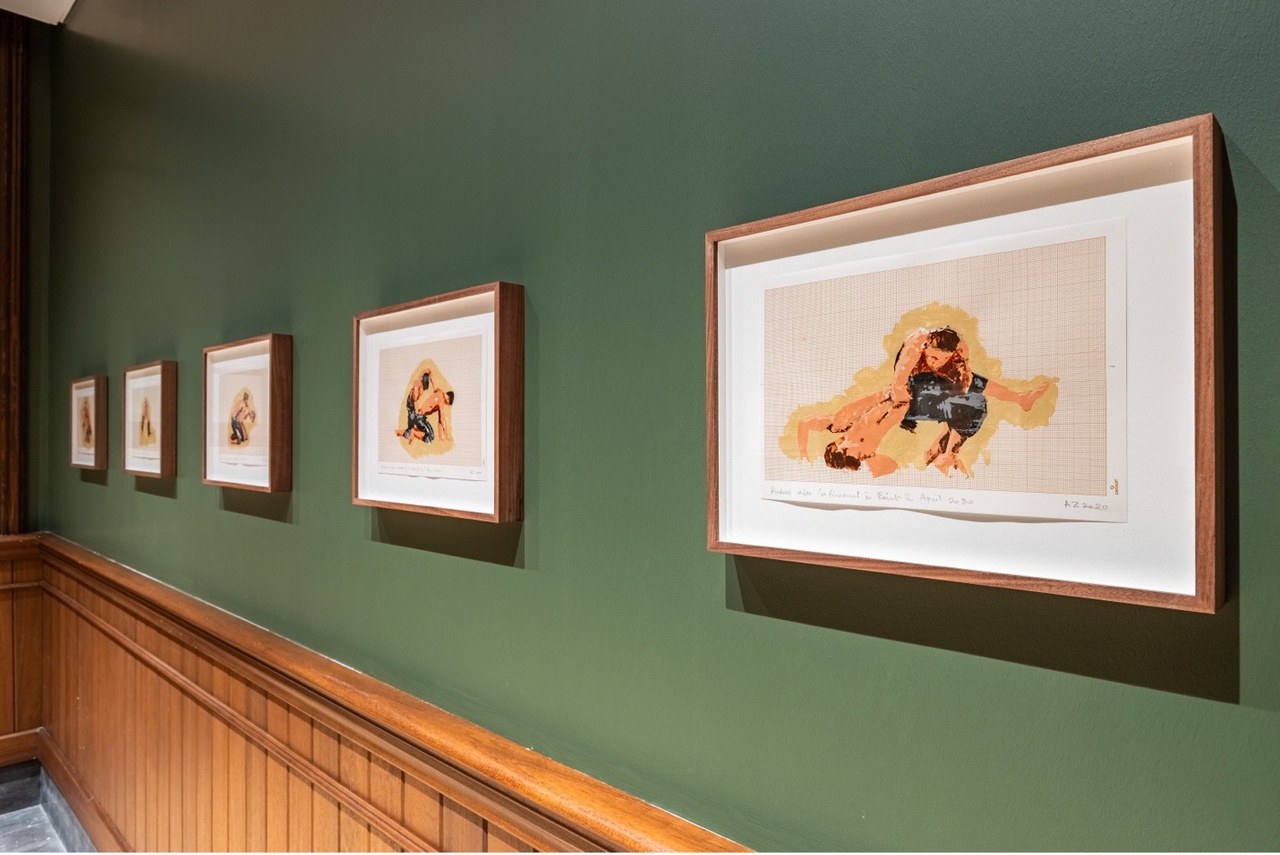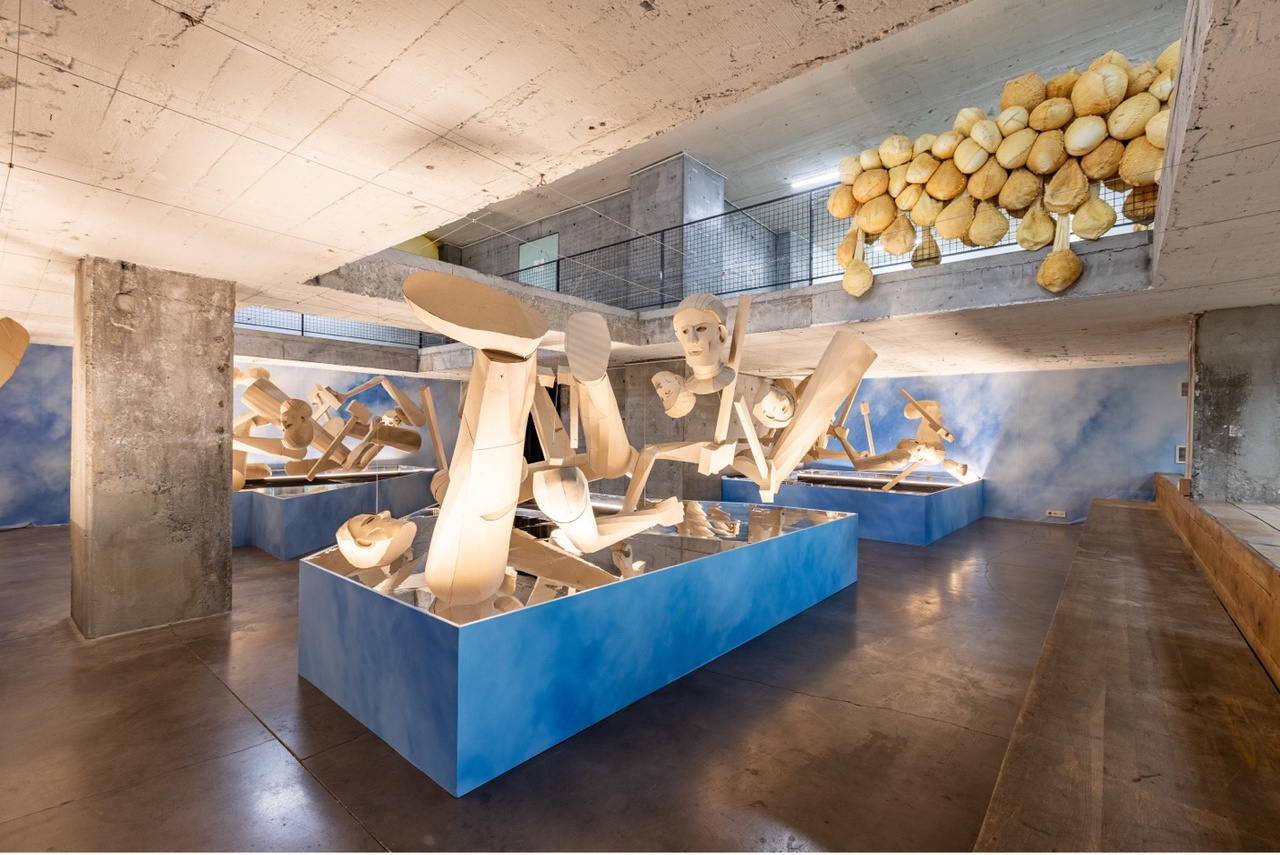HOBBLING ON George MacBeth on the 18th Istanbul Biennial

Khalil Rabah, “Red Navigapparate,” 2025, 18th Istanbul Biennale, Istanbul, 2025
Istanbul is a city filled with stray cats. Linger for longer than a few minutes in any cafe or bar and one will amble over to your table, if it wasn’t there already. For all that these strays enthrall the city’s many visitors, conjuring iPhones out from pockets, there’s also something foreboding about them. After a few days in the city, I was reminded of the moment in recent Nobel Laureate László Krasznahorkai’s novel The Melancholy of Resistance, when the reclusive composer Mr. Eszter finally leaves his self-imposed seclusion and confronts the immense population of feral cats that have taken over the center of his small Hungarian town, pitched as it is on the brink of descending into chaos:
The 18th Istanbul Biennial, titled “The Three-Legged Cat,” sought a quality similar to Krasznahorkai’s “tsars of a long-expected dark age” in the wily figure of the street cat. Through her curatorial framing, Christine Tohmé proposed these resilient creatures as an analogue for contemporary survival amidst the ruination of authoritarian and genocidal decadence, focusing on how they practice a sort of “self-preservation as a form of worldbuilding.” [2] Three-legged or “tripod” cats can, after all, still jump, run, and play, although admittedly somewhat less nimbly than their quadrupedal peers. The three-leggedness here also had a more quotidian meaning, as a way of glossing the Biennial’s prolonged extension across three years, for the first time in its 18 editions. The first leg was this opening exhibition, with upcoming years set to include the establishment of an Istanbul Biennial Academy, workshops, performances, and a concluding exhibition in 2027.

Akram Zaatari, “Olive Green,” 2025, 18th Istanbul Biennale, Istanbul, 2025
Perhaps the framing was also informed by the Istanbul Biennial as an institution, which is also scarred by recent events and accordingly intent on finding strategies to ensure its own self-preservation and hobble on into the future (three-leggedly or otherwise) without incurring further reputational injury. Tohmé, who lives and works in Beirut, secured the gig for this belated biennial following the furor that engulfed her predecessors. Accusations that the İKSV (the Istanbul Foundation for the Arts, which runs the Biennial) lacks transparency stemmed from the organization’s rejection in 2023 of the Biennial’s independent advisory board’s unanimous recommendation of Defne Ayas as curator (on the waffly grounds that “it wasn’t the right time”) and the subsequent helicoptering in of Iwona Blazwick (who was herself a member of the Biennial advisory board). The scandal this decision ignited in the Turkish art world and beyond led to Blazwick’s stepping down and the event’s postponement to this year. Critics at the time emphasized that the İKSV’s jumpiness most likely originated from Ayas having previously curated the exhibition that appeared in the Turkish pavilion at Venice in 2015, by the Turkish-Armenian artist Sarkis. Sarkis exhibited in both the Turkish and Armenian pavilions, but it was a passing reference to the Armenian Genocide in the catalogue for the Turkish pavilion that resulted in the Turkish government intervening to pulp the book. Sarkis and Ayas then presented the remaining copies of this catalogue in a sort of mock mausoleum within the pavilion.
This was all welded to an ongoing critique of the domination of the Turkish art world by five large business families, and of the Biennial’s dogged pursuit of international mega-curators at the expense of curators from the region, with Vasif Kortun (who helped establish and run the first few editions) lamenting to Hyperallergic that “the biennial does not know which geography it is in. There has not been a single curator from the Balkans or the southern Mediterranean. Instead, we’ve seen a succession of white Europeans since 2015.” [3] So much, then, for resilience.
The “first leg” of this year’s edition featured 47 artists spread across eight venues throughout the Beyoğlu neighborhood in the European quarter, with works dotted in a manageable parcours around Galataport and the winding streets of the old city (the great hulking forms of Bosphorus cruise liners periodically looming up in one’s peripheral vision). The most noteworthy of these sites was the crumbling stucco mass of the Former French Orphanage, where the Palestinian artist Khalil Rabah’s Red Navigapparate was installed in the grounds. Rabah’s installation cleaved a gravel courtyard into two spaces separated by a narrow strip of water (into which I saw more than one stiletto plunge during the opening press conference). On one side of this faintly trickling channel, the artist assembled an abundant food forest of 100 olive, citrus, and nut trees planted in red barrels mounted onto palettes. On the other, raised onto a marble pedestal, was the red pallet jack that would in principle enable one to transport these palettes (were it not for the stream that divided them). I encountered the three simple elements constituting Ramah’s work – the means of sustenance, the means of transportation, and the border – as my phone filled with updates from the Global Sumud Flotilla setting sail into international waters, intending to break the Israeli siege and bring vital humanitarian aid to Gazans. Ramah’s highly distilled reflection on the frozen mobility of a captive population suffering under occupation, deprivation, and constant bombardment (in proximity to conditions of abundance) also found formal and conceptual resonances with Abdullah Al Saadi’s Stone Slippers (2013), installed around the corner at the refurbished Zihni Han building. Al Saadi’s sea of brute stone flip-flop sculptures – inspired by an Emirati folk custom of throwing one’s sandals in the sea in hopes of land forming around them – again played with states of enforced sedentariness, clipped wings, and three-leggedness.

Pilar Quinteros, “Working Class,” 2025, and Eva Fàbregas, “Exudates,” 2025, 18th Istanbul Biennale, Istanbul, 2025
There was a lot of painting in the show, all of it figurative but with very little kowtowing to currently ascendant neo-historicist or appropriative tendencies (with the exception of Ali Eyal’s rich, Georg Baselitz-meets-Judge Dredd nightmarescapes of his upbringing during the Iraq War). In place of brash “zombie figuration,” an oneiric, graphically crisp, flattened style prevailed – as in the suite of eight paintings by the Lebanese artist Willy Aractingi and in Ian Davis’s disquieting canvases, with their depictions of strange rituals amongst gaggles of identically dressed butlers and men in suits.
Akram Zaatari’s magnificent acrylic cycle of male oil wrestlers, produced under confinement during the Covid lockdown in 2020 in Beirut, were by far the standout paintings in the Biennial. Eruptions of mangled flesh on sheets of exposed graph paper, these exuberant studies took on new dimensions when encountered in Turkey, where this highly ritualized homosocial – not to mention homoerotic – game of grappling is the national sport. Zaatari’s wrestlers seemed compositionally in dialogue with Francis Bacon’s motif of agonistic-erotic scenes of male wrestling, from Two Figures (1953) onward (works that themselves emerged from Bacon’s close studies of Eadweard Muybridge photos). Largely faceless and shorn of any clear environmental markers beyond their ochre ground, the hands of Zaatari’s combatants were sometimes melded dexterously into the torsos of their opponents, or else disappeared into their kisbet (the leather trousers in which oil wrestlers perform). The paintings were themselves a feat of oil wrestling, ambivalently straining in multiple directions, evidently pining for the forbidden intimacy of contact under the socially deprived conditions of Covid lockdown, while also slyly wriggling loose from the normative weight of the masculinist tradition they depicted. They were also one of several points at which Tohmé sought to spotlight queer artists in her show – a brave decision given the context of Erdoğan’s heightening of anti-LGBTQ policies in the region (Turkey is, for instance, currently drafting a judicial reform bill that would seek to imprison those who publicly promote or depict gender identities or expressions deemed “contrary to biological sex” or “against public morals”).
In the low-ceilinged exhibition space at Meclis-i Mebusan 35, Pilar Quinteros’s Working Class (2025) playfully disassembled and fragmented the anatomical form of a monumental sculpture, The Worker (1973), by the Turkish sculptor Muzaffer Ertoran. Rendered by Quinteros in deceptively weighty cardboard armatures, the now useless limbs, head, and totemic hammer of Ertoran’s sculpture dangled aloft, multiplied by mirrors that further fragmented them. This installation gave an exploded view of the dissolution of the worker’s movement in the last 50 years. The collective body of the working class, as epitomized by Ertoran’s idealized worker, was here subjected to the selfsame processes of parceling-off and enfeeblement as organized labor under neoliberalism’s expansion. Quinteros’s exploded worker was well offset against Eva Fàbregas’s biomorphic latex Exudates (2025) sculpture, which encroached from the mezzanine upstairs, its shriveled forms organically expanding across the space in such a way that you felt they would only continue to multiply if you took your eyes off them.

Ana Alonso, “What the Mine Gives the Mine Takes,” 2020, 18th Istanbul Biennale, Istanbul, 2025
Particularly in the smaller spaces throughout Karaköy, the exhibition’s cohesion and character began to dissolve, and one could have been forgiven for checking the map to confirm precisely which international art exhibition one was exploring. After all, at least 12 of the artists featured in the “Three-Legged Cat” are frequent fliers on the recent biennial circuit, having recently appeared in or being set to appear in multiple major biennials. This glocalized disorientation was only heightened by the self-enclosed affordances of biennale art, which in the current moment doesn’t favor work that “speaks to us like elves in fairytales” (as Adorno characterized aesthetic cryptography [4] ) but rather that which speaks to us with the intonation of a secondary school teacher announcing the moral at the end of a fable, in case we hadn’t already figured it out. Several multimedia installations felt the need to explain themselves in this fashion, with their forms then emerging almost as an afterthought from a typology of gestures familiar from other biennials. Works like Doruntina Kastrati’s 2025 A Horn That Swallows Songs (on the invisible labor of factory workers making lokum, aka Turkish delight), Ola Hassanain’s 2024 A Whispering Dam (on irrigation and environmental precarity in the Sudan), and Ana Alenso’s 2020 What the Mine Gives, the Mine Takes (on the ecological degradation wrought by gold mining in the Amazon) may have been thematically disparate, but they all shared the “upmarket informational-allegorical apparatus” aesthetic that now forms a kind of path dependency at global art shows. This convergence of approaches, alongside the absence of any site-specific work – pieces that registered a lasting impression on the rapidly mutating urban fabric of Istanbul (either conceptually or materially) – couldn’t help but knock the bottom out of Tohmé’s claims about the Biennial functioning as an “index of persistence.” [5]
“18th Istanbul Biennial: The Three-Legged Cat,” September 20–November 23, 2025.
George MacBeth is a writer and editor living in Berlin.
Image credits: All courtesy of the artist; 2. courtesy Sfeir-Semler Gallery, and Thomas Dane Gallery; all photos Sahir Ugur Eren
Notes
| [1] | László Krasznahorkai, The Melancholy of Resistance, trans. George Szirtes (Profile Books, 2016). |
| [2] | Christine Tohmé, “Introduction,” in 18th Istanbul Biennial: The Three-legged Cat, exh. broschure (Istanbul Foundation for Culture and Arts, 2025), 20. |
| [3] | Hrag Vartanian, “You Can Never Be Complicit Enough for the Turkish Art World,” Hyperallergic, August 10, 2023. |
| [4] | Theodor W. Adorno, Aesthetic Theory, trans. Robert Hullot-Kentor (Bloomsbury, 2013), 173. |
| [5] | As Tohmé described it during the press conference held on the opening day of the Biennial. |

